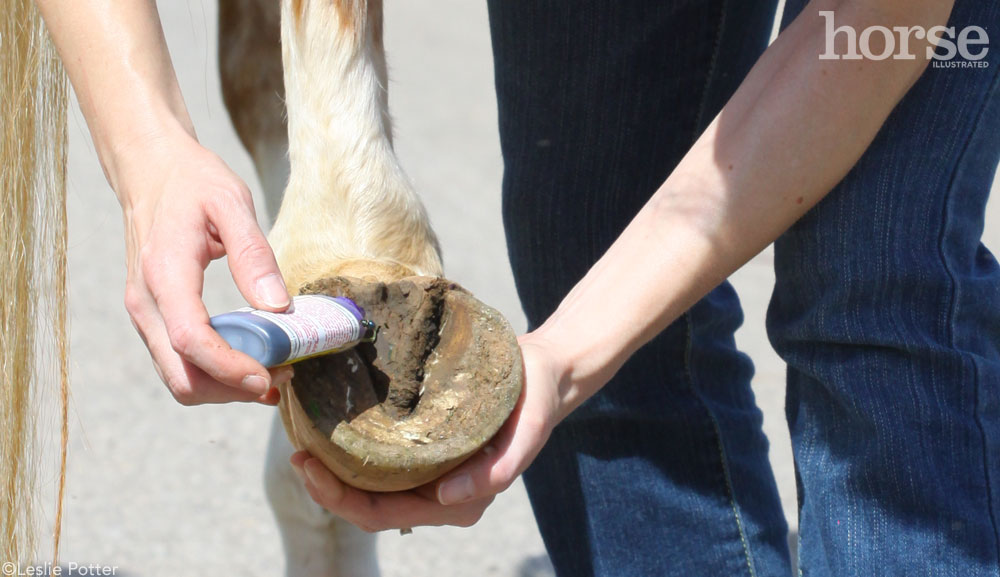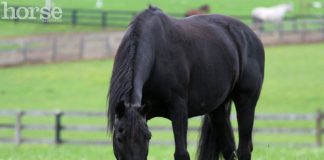
If you have horses, chances are you’ll see thrush firsthand sooner or later. Thrush is a bacterial infection, though it’s thought that yeast and fungal infections might also contribute to it.
If caught early, thrush is usually quite easy to treat and resolve. If left for a period of time, thrush will not only eat away the frog, but it can penetrate the sole and work its way into vital structures. Another incentive for finding and treating thrush early is that once the infection enters the lower areas of the frog, it can be difficult to cure because most topical treatments can’t reach all the deep nooks and crannies.
While thrush is most often seen in horses that must stand in muck and wet conditions, it’s also found in horses with dry stabling. It can occur toward the end of a shoeing cycle, when flaps of the frog grow over the sulci and trap dirt and moisture. Horses with contracted heels can be prone to thrush because their hoof conformation narrows the sulci so dirt and manure aren’t as easily dislodged.
Prevention:
- Daily hoof picking is a key to preventing thrush. Be sure to really clean out the sulci rather than just picking out the sole.
- Regular exercise contributes to overall hoof quality by increasing circulation.
- A clean, dry environment helps prevent the organisms that cause thrush.
Treatment:
- Trim the frog. Have your farrier evaluate your horse’s hooves if you suspect thrush. If the frog is overgrown, the farrier will trim it. This gets rid of the infected parts of the frog and allows air to circulate better around the frog. If the frog isn’t trimmed first, all the anti-thrush products in the world won’t help.
- Clean the hoof. After the frog is trimmed, scrub the entire foot with a stiff brush and warm water. Allow the foot to dry completely before applying a thrush product.
- Apply topical product. Any tack store or catalog will offer a variety of thrush products. From thick ointments to liquids, all promise to treat thrush and kill the infection. Ask your vet for his or her advice on what works best in your area and given your particular conditions.
Other Remedies:
- Strong (7%) iodine. This can be effective for mild cases of thrush that don’t penetrate into the deep layers of the frog. However, it can also dry the hoof if used too often.
- Bleach. You might hear that household bleach is a good product for treating thrush, but it’s not recommended. Besides overdrying the hoof and frog, it doesn’t really kill the infection. Plus, bleach can cause significant damage to sensitive internal structures of the hoof if the thrush has created deep pockets of infection that lie next to the structures.
- Continue ongoing care. Pick out the hooves every day and keep the horse in a clean, dry environment until the problem clears up. The horse doesn’t have to be kept in a bedded stall, but be sure he has dry places to stand for most of the day. Rubber mats can be a lifesaver for those who must contend with mud in winter and spring. Once the thrush is cured, strive to maintain this dry, clean environment.
If your horse is troubled with frequent bouts of thrush, consult your vet and farrier.
Further Reading
Guide to Horse Hoof Problems
Eight Hoof Care Myths
The author has handled horse hooves for 20 years and has suffered only one broken toe.






Hey,
My horse has a minor case of thrush. I have consulted my farrier and he said it is very common. Also he said it should be no problem and should clear up easily. Still I am worried about my horse. I know everything will be ok, but I just care alot about my horse and after reading things on the internet about thrush it makes me even more scared. I like this article and it makes me a little more incuraged about treatments, ect. Thanks!!!!!
Helpful article.Especially in that it points out that contrary to popular belief thrush is as much, if not more a bacterial infection than a fungal infection.We just finished two months of twice day therapy on a horse new to us. Scrubbed the hooves twice a day with antibacterial dish soap and water/ dried them/ then applied a fifty/ fifty mix of neosporin and clotrimazole cream 1%(athletes foot creme)generously to the hoof,injecting it into any cracks and crevases with a plastic syringe.The condition took a good two months to cure up. Now the thrush is gone but the horse still seems tender on one foot. we hope that time will heal that tenderness….
I cleaned my friends horses hooves and found a serious case of thrush. When I picked the horses one foot in the frog, the horse winced in pain then the frog area started bleeding deep in the frog somewhere deep. How do I treat this. And is it serious since the frog started bleeding?
I use a spray of copper sulphate, water and a little vinegar. I only have to spray a few times and the thrush clears up! Just wondering though if this treatment may cause any damage to my horse’s hooves?